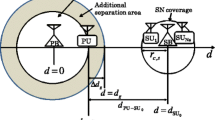Abstract
Cognitive radio systems should not only have the ability to sense and exploit “frequency spectrum holes”, but also the ability to sense and utilize “spatial spectrum holes”. In this paper, we consider the issue of maximizing the throughput of the cognitive systems by fully utilizing “spatial spectrum holes” brought in by multiple cognitive users, in the scenario where a pair of licensed users and a cognitive broadcast system share multiple spectrum bands. By exploiting the channel reciprocity under the premise that the licensed system adopts the time-division-duplexing (TDD) mode, we propose a more practical cognitive access scheme that can sense the interference at the licensed user caused by the cognitive transmitter, based on the existing feedback signals from the licensed user to the licensed base station. Taking both interferences from the licensed base station to the cognitive receiver and from the cognitive transmitter to the licensed user into consideration, we investigate the optimal user scheduling and power allocation scheme that can maximize the ergodic sum rate of the cognitive system. We show that scheduling the user whose channel gain to interference and noise ratio (CGINR) is the largest for each frequency band is optimal. We also derive the dynamic power allocation scheme meeting the three practical constraints, i.e., the transmitter’s average transmission power constraint, the power amplifier’s instantaneous transmission power constraint, and the interference power constraint at the licensed user. The result shows that in different coherent time intervals and different frequency bands, the power allocation has a multi-level waterfilling structure. Theoretical analysis shows that the strategy scheduling user with the largest CGINR introduces significant performance improvement compared with the traditional strategy scheduling user with the largest channel gain to noise ratio (CGNR). We also illustrate the impact of power constraints and the number of users on system performance by simulation.
Similar content being viewed by others
References
Federal Communications Commission. Spectrum Policy Task Force Report, FCC 02-155. 2002
Mitola J, Maguire G Q. Cognitive radios: Making software radio more personal. IEEE Pers Commun, 1999, 6: 13–18
Zhao Q, Swami A. A decision-theoretic framework for opportunistic spectrum access. IEEE Trans Wirel Commun, 2007, 14: 14–20
Ghasemi A, Sousa E S. Fundamental limits of spectrum-sharing in fading environments. IEEE Trans Wirel Commun, 2007, 6: 649–658
Weiss T A, Jondral F K, Karlsruhe U. Spectrum pooling: an innovative strategy for the enhancement of spectrum efficiency. IEEE Commun Mag, 2004, 42: S8–14
Geirhofer S, Tong L, Sadler B M. Cognitive Radios for dynamic spectrum access — dynamic spectrum access in the time domain: modeling and exploiting white space. IEEE Commun Mag, 2007, 45: 66–72
Zhang R, Liang Y C. Exploiting multi-antennas for opportunistic spectrum sharing in cognitive radio networks. IEEE J Sel Topics Signal Process, 2008, 2: 88–102
Perlaza S M, Lasaulce S, Debbah M. From spectrum pooling to space pooling:opportunistic interference alignment in MIMO cognitive networks. IEEE Trans Signal Process, 2010, 58: 3728–3741
Bixio L, Ottonello M, Raffetto M, et al. Cognitive radios with multiple antennas exploiting spatial opportunities. IEEE Trans Signal Process, 2010, 58: 4453–4459
Zhao G D, Ma J, Li G Y, et al. Spatial spectrum holes for cognitive radio with relay-assisted directional transmission. IEEE Trans Wirel Commun, 2009, 8: 5270–5279
Huang S H, Ding Z, Liu X. Non-Intrusive cognitive radio networks based on smart antenna technology. In: Global Telecommunications Conference, 2007. 4862–4867
Zhang R, Cui S G, Liang Y C. On ergodic sum capacity of fading cognitive multiple-access and broadcast channels. IEEE Trans Inf Theory, 2009, 55: 5161–5178
Ban T W, Choi W, Jung B C. Multi-user diversity in a spectrum sharing system. IEEE Trans Wirel Commun, 2009, 8: 102–106
Tajer A, Wang X D. Multiuser diversity gain in cognitive networks. IEEE/ACM Trans Netw, 2010, 18: 1766–1779
Zhang R, Liang Y C. Investigation on multiuser diversity in spectrum sharing based cognitive radio networks. IEEE Commun Lett, 2010, 14: 133–135
Li L F, Goldsmith A J. Capacity and optimal resource allocation for fading broadcast channels-part I: ergodic capacity. IEEE Trans Inf Theory, 2001, 47: 1083–1102
Tse D N. Optimal power allocation over parallel Gaussian broadcast channels, 1998 [Online]. Available at http://www.eecs.berkeley.edu/?dtse/broadcast2.pdf
Palomar D P, Fonollosa J R. Practical algorithms for a family of waterfilling solutions. IEEE Trans Signal Process, 2005, 53: 686–695
Author information
Authors and Affiliations
Corresponding author
Rights and permissions
About this article
Cite this article
Wang, Q., Wang, H. & Yin, Q. Optimal user scheduling and power control in multi-user cognitive broadcast systems. Sci. China Inf. Sci. 55, 1402–1414 (2012). https://doi.org/10.1007/s11432-012-4562-2
Received:
Accepted:
Published:
Issue Date:
DOI: https://doi.org/10.1007/s11432-012-4562-2




